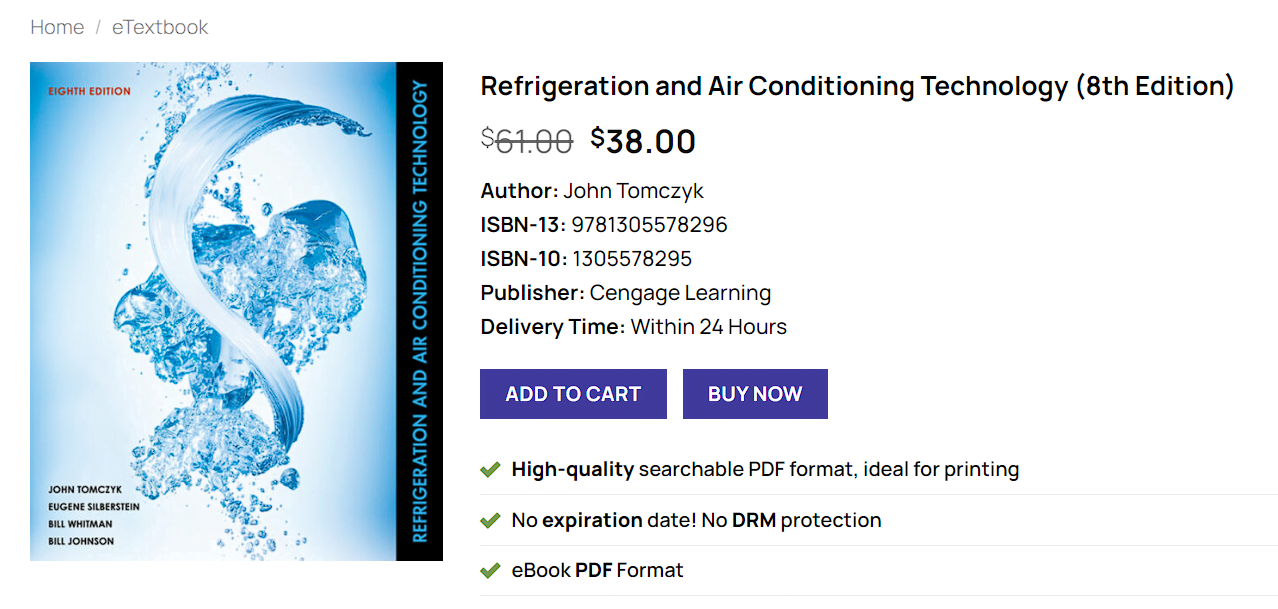The “Refrigeration and Air Conditioning Technology 8th Edition” serves as a comprehensive guide for both students and professionals in the HVACR (Heating, Ventilation, Air Conditioning, and Refrigeration) industry. This edition introduces several key updates and additions that distinguish it from its predecessors, ensuring that it remains a relevant and invaluable resource in the ever-evolving field of HVACR technology.
One of the primary enhancements in this edition is the incorporation of the latest advancements in HVACR technologies. The book delves into the fundamental concepts of refrigeration cycles and air conditioning systems, providing a robust foundation for readers. Additionally, it explores cutting-edge developments such as high-efficiency systems, environmentally friendly refrigerants, and advanced diagnostic tools. These updates reflect the ongoing innovations and regulatory changes within the industry, making the textbook a crucial resource for staying current with modern practices.
The structure of the “Refrigeration and Air Conditioning Technology 8th Edition” is meticulously organized to facilitate a systematic understanding of the subject matter. The textbook is divided into chapters that progress logically from basic principles to more complex applications. Initial chapters cover essential topics such as thermodynamics, heat transfer, and the properties of refrigerants. As readers advance, they encounter detailed discussions on system components, design, installation, and maintenance procedures. This structured approach ensures that readers gain a comprehensive understanding of both theoretical concepts and practical skills required in the HVACR field.
Furthermore, the textbook emphasizes the importance of understanding the principles, operation, and maintenance of refrigeration and air conditioning systems. By integrating theoretical knowledge with hands-on applications, the book prepares students and professionals to tackle real-world challenges effectively. Whether used as a primary textbook in educational settings or as a reference guide for industry practitioners, the “Refrigeration and Air Conditioning Technology 8th Edition” stands out as an essential resource for mastering the complexities of HVACR technology.
Key Concepts and Principles in Refrigeration and Air Conditioning Technology
The ‘Refrigeration and Air Conditioning Technology 8th Edition’ serves as an indispensable resource, laying out the foundational principles vital for understanding modern HVACR systems. Central to this field is the refrigeration cycle, a process governed by thermodynamic principles. The cycle typically involves four key stages: compression, condensation, expansion, and evaporation. Each stage plays a crucial role in the heat exchange process, enabling cooling and refrigeration.
Various refrigerants are used in these cycles, each with unique properties and environmental impacts. Historically, chlorofluorocarbons (CFCs) were widely used, but their detrimental effect on the ozone layer has led to a shift towards more environmentally benign alternatives such as hydrofluorocarbons (HFCs) and natural refrigerants like ammonia and carbon dioxide. Understanding the environmental impact of these refrigerants is essential for compliance with international regulations and sustainability goals.
Heat transfer mechanisms are fundamental to refrigeration and air conditioning. These include conduction, the transfer of heat through a material; convection, the transfer of heat through fluid motion; and radiation, the transfer of heat through electromagnetic waves. Mastery of these principles is critical for designing and optimizing HVACR systems to ensure efficient thermal management.
Refrigeration systems come in various types, with vapor-compression and absorption systems being the most prevalent. Vapor-compression systems are widely used due to their efficiency and versatility. They involve a mechanical compressor to circulate the refrigerant. On the other hand, absorption systems use a heat source to drive the refrigeration cycle, making them suitable for applications where waste heat is available or in locations with limited electricity.
The core components of these systems include compressors, which increase refrigerant pressure; condensers, which expel heat; evaporators, which absorb heat; and expansion devices, which regulate refrigerant flow. Each component must function seamlessly to maintain system efficiency and reliability.
Psychrometrics, the study of air properties, is another critical area of focus. It involves analyzing the humidity, temperature, and moisture content of air, which is paramount for designing effective air conditioning systems. Proper psychrometric analysis ensures that HVACR systems can control air quality and comfort within various environments.
Technological advancements continue to “Refrigeration and Air Conditioning Technology 8th Edition” shape the field of refrigeration and air conditioning. Energy-efficient systems, smart HVACR technologies, and environmentally-friendly refrigerants are at the forefront of this evolution. These innovations not only enhance system performance but also reduce environmental impact, aligning with global efforts towards sustainability.

